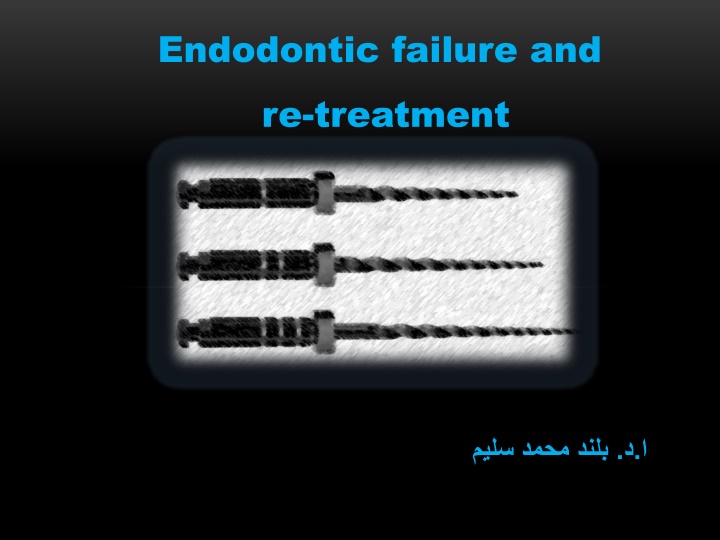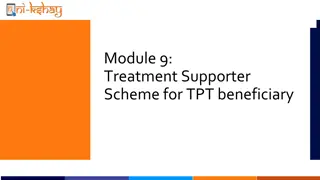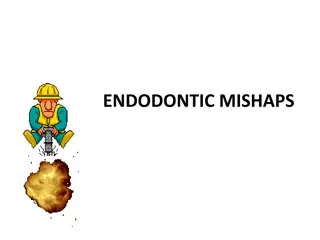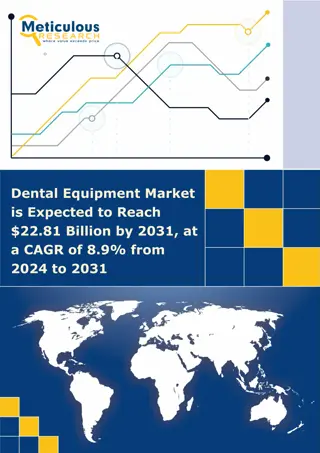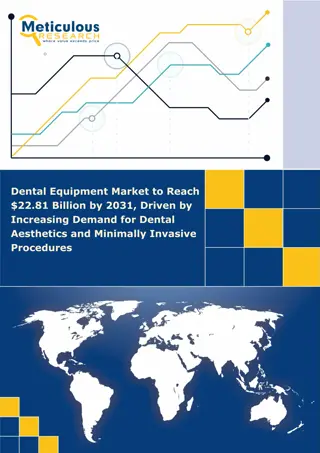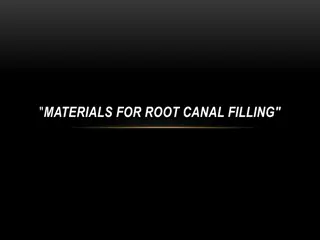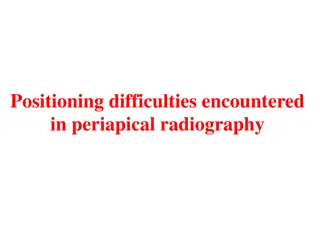Evaluation of Endodontic Treatment Success Criteria
In endodontics, success is determined by achieving established goals. Evaluation methods include clinical, radiographic, and histological criteria. Clinical success is indicated by absence of symptoms like pain or tenderness, while radiographic criteria include normal periodontal ligament space and canal obturation. Histological success involves absence of inflammation and regeneration of supporting structures. Understanding these success criteria is vital for assessing the outcomes of root canal treatment.
Download Presentation

Please find below an Image/Link to download the presentation.
The content on the website is provided AS IS for your information and personal use only. It may not be sold, licensed, or shared on other websites without obtaining consent from the author.If you encounter any issues during the download, it is possible that the publisher has removed the file from their server.
You are allowed to download the files provided on this website for personal or commercial use, subject to the condition that they are used lawfully. All files are the property of their respective owners.
The content on the website is provided AS IS for your information and personal use only. It may not be sold, licensed, or shared on other websites without obtaining consent from the author.
E N D
Presentation Transcript
Endodontic failure and re-treatment . .
Success is defined by goals Success is defined by goals established to be achieved established to be achieved
The The goal to to prevent prevent or goal of of Endodontic Endodontic therapy or heal heal the the disease therapy is disease. . is
Evaluation of success of endodontic treatment Clinical criteria Radiographic Criteria Histological Criteria Evaluation the success or failure of endodontic treatment could be evaluated by combination of various criteria
Evaluation the success of RCT Clinical criteria for success Presence of symptoms indicate the presence of pathology While the Absence of PAIN not confirm the absence of disease. tenderness to percussion or palpation evidence of subjective discomfort. sign of infection or swelling. sinus tract or integrated periodontal disease
Clinical criteria for success Normal NO tenderness to percussion or palpation NO evidence of subjective discomfort. NO sign of infection or swelling. NO sinus tract or integrated periodontal disease Tooth having normal form, function and aesthetics Normal tooth mobility Minimal to no scarring or discoloration
Radiographic Criteria for Success of Endodontic Treatment .Normal or slightly thickened periodontal ligament space .Reduction or elimination of previous rarefaction . No evidence of resorptions . Normal lamina Dura . A dense three dimensional obturation of canal space
Histological Criteria for Success . Absence of inflammation . Regeneration of periodontal ligament, bone, cementum . Presence of osseous repair . Repair of cementum . Absence of resorption . Repair of previously resorbed areas. While the success of RCT is reduced in the presence of chronic inflammation for long time even with NO symptoms.
Factors Affecting Success or Failure of Endodontic Therapy in Every Case: . Diagnosis and the treatment planning . Radiographic interpretation . Anatomy of the tooth and root canal system . Debridment of RC space . Asepsis of treatment regimen .Quality and extend of apical seal . Quality of post endodontic restoration . Systemic health of the patient . Skill of the operator
Factors Affecting success or Failure of a Particular case . pulp status . Periodontal status . Size of periapical radiolucency .Canal anatomy like degree of canal calcification, .presence of accessory or lateral canals, resorption, degree of curvature of canal etc. . Iatrogenic errors . Crown and root fracture . Extend and quality of the obturation . Quality of the post endodontic restoration . Time of post treatment evaluation.
Case Selection for Endodontic Retreatment Retreatment is usually indicated in symptomatic endodontically treated tooth or in asymptomatic teeth with improper done. 1. Careful history of patient should be taken to know the nature of case, pathogenesis and urgency of the treatment etc. 2. Evaluate the anatomy of root canal in relation to canal curvature, calcifications, un usual configurations etc. 3. Evaluate the quality of obturation of primary endodontic treatment. 4. Check for iatrogenic complications like separated instruments, ledge, perforations, zipping, canal blockages etc. 5. Consider the cooperation of the patient which is mandatory for retreatment procedure
Factors Affecting Prognosis of Endodontic Treatment . Presence of any periapical radiolucency . Quality of obturation . Apical extension of the obturation material . Bacterial status of the canal . Observation period . Iatrogenic complication
Contraindication of Endodontic Retreatment . .Unfavorable remaining dentine thickness). . . Insufficient crown/root ratio root anatomy (shape, taper, . . Presence of untreatable root resorptions or perforations . . Presence of root or bifurcation caries
Problems commonly Encountered during Retreatment . Unpredictable result . Frustration . Cost factor . Time consuming
